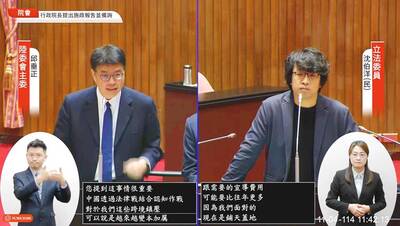Chinese coast guard ships yesterday sailed into disputed waters at the center of a bitter row with Tokyo, officials said, a day after China blasted Japanese lawmakers for visiting a controversial war shrine.
The four government vessels spent about two hours within the 12 nautical mile (22.2km) band around the Tokyo-controlled Senkaku Islands — which Taiwan calls the Diaoyutai Islands (釣魚台) and Beijing refers to as the Diaoyu Archipelago (釣魚群島) — in the East China Sea.
Japan said the vessels had left territorial waters by 12:30pm, but remained in the vicinity.
Following the incursion, the Japanese Foreign Ministry’s Asian and Oceanian Affairs Bureau Director-General Junichi Ihara lodged a protest with a senior diplomat at the Chinese embassy in Tokyo, Kyodo news agency reported.
Kyodo said seven ships were spotted just outside of the waters earlier yesterday, before the four Chinese coast guard vessels entered the disputed waters.
The incursion came after Beijing on Thursday summoned Japan’s ambassador to condemn a visit by nearly 100 Japanese lawmakers to the Yasukuni Shrine on the anniversary of Tokyo’s World War II surrender.
Japanese politicians’ visits to the site are seen as a slap in the face by neighboring nations, especially China and South Korea, which suffered from Tokyo’s imperialist expansion in the first half of the 20th century.
Yesterday’s incident was the latest in a series of incursions by Chinese ships as relations between Tokyo and Beijing plumb all-time lows.
Last week, the Japanese foreign ministry summoned Beijing’s envoy after Chinese ships spent more than a day in the disputed waters, their longest incursion since the long-simmering dispute erupted again last year after Tokyo nationalized some of the chain.
The islands — believed to harbor vast natural resources below their seabed — are seen as a potential flashpoint that some observers fear could lead to armed conflict between the Asian giants.

CALL FOR SUPPORT: President William Lai called on lawmakers across party lines to ensure the livelihood of Taiwanese and that national security is protected President William Lai (賴清德) yesterday called for bipartisan support for Taiwan’s investment in self-defense capabilities at the christening and launch of two coast guard vessels at CSBC Corp, Taiwan’s (台灣國際造船) shipyard in Kaohsiung. The Taipei (台北) is the fourth and final ship of the Chiayi-class offshore patrol vessels, and the Siraya (西拉雅) is the Coast Guard Administration’s (CGA) first-ever ocean patrol vessel, the government said. The Taipei is the fourth and final ship of the Chiayi-class offshore patrol vessels with a displacement of about 4,000 tonnes, Lai said. This ship class was ordered as a result of former president Tsai Ing-wen’s (蔡英文) 2018

‘SECRETS’: While saying China would not attack during his presidency, Donald Trump declined to say how Washington would respond if Beijing were to take military action US President Donald Trump said that China would not take military action against Taiwan while he is president, as the Chinese leaders “know the consequences.” Trump made the statement during an interview on CBS’ 60 Minutes program that aired on Sunday, a few days after his meeting with Chinese President Xi Jinping (習近平) in South Korea. “He [Xi] has openly said, and his people have openly said at meetings, ‘we would never do anything while President Trump is president,’ because they know the consequences,” Trump said in the interview. However, he repeatedly declined to say exactly how Washington would respond in

WARFARE: All sectors of society should recognize, unite, and collectively resist and condemn Beijing’s cross-border suppression, MAC Minister Chiu Chui-cheng said The number of Taiwanese detained because of legal affairs by Chinese authorities has tripled this year, as Beijing intensified its intimidation and division of Taiwanese by combining lawfare and cognitive warfare, the Mainland Affairs Council (MAC) said yesterday. MAC Minister Chiu Chui-cheng (邱垂正) made the statement in response to questions by Democratic Progressive Party (DPP) Legislator Puma Shen (沈柏洋) about the government’s response to counter Chinese public opinion warfare, lawfare and psychological warfare. Shen said he is also being investigated by China for promoting “Taiwanese independence.” He was referring to a report published on Tuesday last week by China’s state-run Xinhua news agency,

‘ADDITIONAL CONDITION’: Taiwan will work with like-minded countries to protect its right to participate in next year’s meeting, the foreign ministry said The US will “continue to press China for security arrangements and protocols that safeguard all participants when attending APEC meetings in China,” a US Department of State spokesperson said yesterday, after Beijing suggested that members must adhere to its “one China principle” to participate. “The United States insists on the full and equal participation of all APEC member economies — including Taiwan — consistent with APEC’s guidelines, rules and established practice, as affirmed by China in its offer to host in 2026,” the unnamed spokesperson said in response to media queries about China putting a “one China” principle condition on Taiwan’s